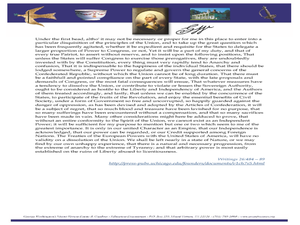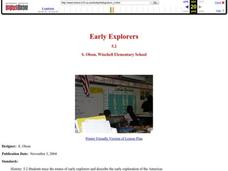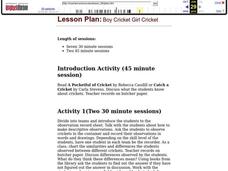Curated OER
A Ticket to Japan
Fourth graders discover similarities and differences in the lifestyles and geography of Utah and Japan. They use a Venn Diagram to compare and contrast daily life and geography in Utah with daily life and geography in Japan. They make...
Curated OER
When I Was Young in Brooklyn
Students identify various techniques used in memoirs. They reflect on similarities and differences betwee two authors. Students define the term memior. They write about various techiques they noticed the authors used. Students write...
Curated OER
Analysis of Data
Learners analyze DNA banding patterns for similarities and differences among individuals and between populations. They examine individual prepared gels then pool the class data to come to an overall conclusion.
Curated OER
Stem-and-Leaf Plots
In this stem-and-leaf plots worksheet, 9th graders solve and complete 9 various types of problems. First, they determine the mean, median, and mode of the stem-and-leaf plot shown. Then, students summarize the similarities and...
Curated OER
Kidding Around In The 1980s
Students examine pop culture of the 1980s. In this historical time period lesson plan, students view a Smurfs cartoon from the 1980s and discuss its similarities and differences to cartoons today. Students work in groups to...
Curated OER
George Washington & the Classics
Learners will compare and contrast famous philosophers with George Washington. In this history activity, students work in small groups to define Classicism, Legalism, Democracy, Republic and Civility, then read some short excerpts...
Curated OER
Primary Lessons for Grades K-2
Students study wildlife and identify similarities and differences between their home and wild environments. In this wildlife lesson plan, students make connections between wildlife and wildlife habitats. Students then build...
Curated OER
Early Explorers
Fifth graders give a presentation about one of the explorers. In this explorers lesson, 5th graders research an explorer and give a presentation to the class. While students are presenting the others are taking notes on a graphic organizer.
Curated OER
Egg Experiment
Students understand that people can appear different on the outside but still be similar on the inside after comparing a white egg to a brown egg.
They then have a class discussion of how even though the eggs were different on the...
Curated OER
How Different Authors Treat Similar Themes - Elephants of Africa
Students watch videos about similar themes presented by two different authors about elephants and their relationship with humans. In this theme analysis lesson, students watch video segments, visit the given websites, and complete...
Curated OER
Good Apples
Students examine how individual differences add to the value of our lives. They select an apple and tell a story to a partner about their apple and the distinguishing characteristics, discuss the significance of individual differences...
Curated OER
Boy Cricket Girl Cricket
Students investigate crickets. In this series of cricket activities, students observe and chart crickets. Students discuss the differences between male and female crickets, record findings in a journal, handle crickets, and read a...
Curated OER
Exploring Descriptive Language With Different Parts of Speech
Students practice experiencing writing with appropriate language and incorporating the eight parts of speech. They assess that many words have multiple functions when used in different contexts. Each student free writes in response to a...
Curated OER
Schools Around the World
Students discover how schools around the world are the same and different. In this international school lesson, students learn about different types of schools from all around the world and the items and activities within these schools....
Curated OER
Comparing and Contrasting-Grassland, Desert, and Forest Elephants
Young scholars compare and contrast different types of elephants. In this environmental science lesson, students examine the characteristics of three species of elephants. Young scholars view a video of each type of elephant...
Curated OER
Compare and Contrast
Encyclopedia Brown asks readers to compare and contrast clues to help Kara and her family solve the mystery of the dripping water. A Venn diagram could be used to make visual the similarities and differences between the two rooms.
Curated OER
Memory in Your World
Students identify similarities and differences between machines with memory and machines without memory. They illustrate how a machine with memory might fit into the student's world.
Curated OER
Let's Get Along
Students examine the book Smoky Night. In this cultural lesson plan, students read the text and discuss why it's important to get along with others. Students complete a Venn diagram to compare and contrast themselves with a peer.
Curated OER
Regular & Irregular Polygons
For this polygons worksheet, 7th graders identify and complete 8 different problems that include determining the types of various polygons. First, they use the table to the left to color each of the polygons illustrated. Then, students...
Curated OER
Symmetry Fun
In this symmetry worksheet, 7th graders identify and complete 12 different lines of symmetry in polygons. First, they color all of the polygons that have a line of symmetry. Then, students circle all of the regular polygons and use the...
Missouri Department of Elementary
Ingredients of a Relationship Recipe
An eye-catching hook makes a smart analogy between ingredients for a food recipe and ingredients for quality relationships. Scholars discuss and list qualities they feel contribute to positive interactions. Pupils create a recipe card...
Missouri Department of Elementary
How Does a Friend Act?
Two puppets showcase social skills while scholars decide whether their actions are positive or negative. Learners take turns with the puppets, acting out scenarios with a peer while the rest of the class decide if they're being a good...
CK-12 Foundation
Area and Volume of Similar Solids: Similar Solids
Five questions make up an interactive designed to boosts knowledge of area and volume of solid figures. Question types include multiple-choice, true or false, and fill-in-the-blank. A scale model changes measurement to provide a visual...
CK-12 Foundation
Sums and Differences of Independent Random Variables: Traveling Seasickness
Use a Punnett square to calculate probabilities. The resource presents a situation in which two patients are randomly selected from a group of patients with a particular illness. Pupils use the interactive to determine the likelihood...























